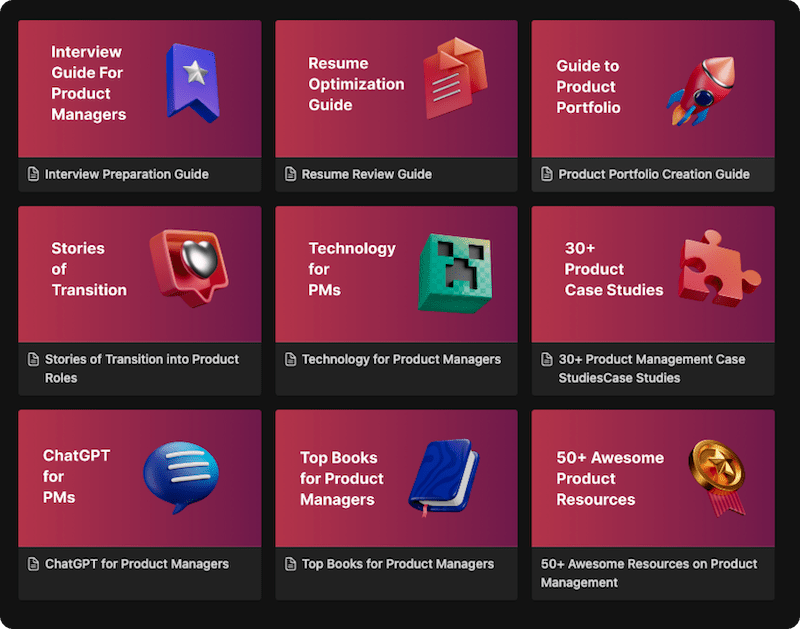Everyone has products they love, but as a Product Manager, it’s crucial to create products that people will like and love. Constantly improving the product is one of the most important tasks for a Product Manager.
The question about your favorite product might seem simple, but it’s actually a common one asked in product interviews.
Some companies even have entire interview rounds dedicated to this case study. To answer it well, you need to explain your thinking clearly and in a structured way.
In this article, we will understand
- Why is this favorite product question usually asked?
- How to answer this question with a structured approach?
- Some real life example solving using the structure approach
Why is the favorite product question asked?
The “favorite product” question is asked a lot in interviews for a few reasons.
First, it helps the interviewer see if you understand what makes a product great. Can you talk about what makes a product special and what it does well or not so well?
Second, it gives them a reference point. It’s easier to have a good conversation about something you know a lot about.
This question helps them see if you’re really passionate about product management, if you care about customers, and if you’re good at solving problems.
So when they ask, “What’s your favorite product and why?” they’re trying to figure out:
- If you know about product design
- If you can give good feedback
- If you know a lot about a specific product
Basically, they want to see if you can understand what makes a product great, if you can give helpful feedback, and if you know a lot about the product you’re talking about.
How to answer this question with a structured approach?
The favorite product question can be well answered using a 5-step framework as explained below
- What is your favorite product and tell me something about it?
- Outline your answer
- Explain the product
- Define the business objective
- Define the Goal we want to achieve
- Understand the user problems
- Select a user type
- List user problems
- Evaluate the solutions and Define Metrics
- Explain how the product solves user problems better than competitors
- Define Metrics to measure the performance of the solutions.
- Discuss trade-offs and suggest improvements
Now that we have already discussed the structured approach, let us use the same approach to explain why these two products are favorites and how we would improve them.
Step 1: Describe the Product and list down its business objectives
LinkedIn is a professional networking platform designed to help users connect with other professionals and find job opportunities.
Users can create a personal profile that includes their work experience, education, and skills, which can be viewed by others.
They can search for job opportunities, join industry-related groups, write articles, and organize offline events.
LinkedIn is available on desktop web and as a mobile app, making it easy for users to stay connected on the go. With over 700 million users worldwide, LinkedIn is one of the most popular professional networking platforms.
5 key business objectives of LinkedIn are
- Connect professionals worldwide.
- Facilitate job opportunities and recruitment.
- Provide resources for professional development.
- Offer recruitment solutions for businesses.
- Provide marketing solutions for businesses.
Step 2: Ask clarifying Questions to trim down the scope of the question
Q) What do we mean by improvement here?
A) It’s up to you. You are free to choose.
Q) Are we focusing on any particular platform like desktop web or mobile app?
A) Let’s consider the mobile app first.
Q) Are we focusing on any particular OS like IOS or Android?
A) Let’s focus on both IOS & Android.
Q) For the improvement are we focusing on a particular region?
A) It’s up to you.
Step 3: Define the Goal you want to achieve.
The goal is to improve user engagement on LinkedIn. Improving user engagement will lead to increased user retention and revenue. Metrics to focus on wil be
- Time spent on the website.
- Stickiness on the platform – WAU/MAU.
Step 4: List the User Segments
Linkedin can have a list of following user segments
- Job Seekers – Individuals using LinkedIn to find job opportunities, connect with employers, and advance their careers.
- Recruiters: Professionals responsible for hiring within companies who use LinkedIn to search for and connect with potential candidates.
- Sales Professionals: Individuals who use LinkedIn to generate leads, build relationships, and grow their business network.
- Entrepreneurs and Business Owners: People who use LinkedIn to network, seek advice, and grow their business.
- Industry Experts and Thought Leaders: Individuals who use LinkedIn to share their expertise, build their personal brand, and establish themselves as thought leaders in their field.
- Students and Recent Graduates: Users who use LinkedIn to connect with professionals, explore career options, and find internships or entry-level positions.
- Freelancers and Independent Contractors: Individuals who use LinkedIn to promote their services, find clients, and network with other professionals in their industry.
We’ll focus on the Job Seeker segment, as they represent a significant portion of LinkedIn’s user base and are vital for the platform’s revenue generation.
Step 5: List the Pain Points for that segment
Following could be the possible pain points for Job Seeker segment on Linkedin
- Job seekers don’t have clarity regarding the status of their applications.
- They are unsure about the format and structure of their resumes.
- They are not aware of the shortcomings in their profile that lead to job application rejections.
- Job seekers find it difficult to distinguish between startup and big corporation job listings.
- They have difficulty finding reviews and feedback about companies and their work culture.
- Lack of visibility into which companies have viewed their profiles.
- Limited access to networking opportunities with professionals in their desired industry.
- Difficulty in standing out among other job applicants.
- Inability to customize job search preferences effectively.
- Uncertainty about which skills are most valued by employers in their industry.
Step 6: List out your Solutions to solve those pain points
- Automated Resume Review System: Implement an automated system that analyzes users’ resumes and provides personalized suggestions for improvements based on the job category they are targeting. This feature would help users enhance their resumes, increasing their chances of getting shortlisted for job interviews.
- 1-1 Mock Interview Sessions: Offer one-on-one mock interview sessions with LinkedIn verified coaches. These sessions would provide users with valuable feedback to improve their interview performance, helping them feel more confident and prepared for real interviews.
- Profile Strength Evaluation: Provide users with a comprehensive assessment of their LinkedIn profiles compared to shortlisted profiles for desired job roles. This feature would highlight areas for improvement, such as skills, experience, and keywords, helping users optimize their profiles to attract more job opportunities.
- Application Status Tracking: Introduce a feature that allows users to track the status of their job applications directly on LinkedIn. This would provide users with clarity regarding the progress of their applications, reducing uncertainty and anxiety.
- Company Reviews and Feedback: Enhance the platform to include company reviews and feedback from current and former employees. This feature would help job seekers gain insights into company culture, work environment, and employee experiences, enabling them to make more informed decisions when applying for jobs.
Step 7: Evaluate the solutions and prioritize them
| Solution | Reach | Impact | Confidence | Effort | RICE Score |
| Resume Reviewer | 8 | 7 | 7 | 6 | 65.3 |
| Mock Interviews | 5 | 9 | 8 | 8 | 45 |
| Profile Strengthening | 7 | 6 | 6 | 7 | 36 |
| Application Tracking | 6 | 7 | 8 | 5 | 67.2 |
| Company Insights | 8 | 8 | 7 | 7 | 64 |
Resume Reviewer:
- Reach: 8 (High number of LinkedIn users would benefit from resume improvement)
- Impact: 7 (Improved resumes increase chances of job application success)
- Confidence: 7 (Moderate confidence in the effectiveness of resume suggestions)
- Effort: 6 (Developing an automated system requires moderate effort)
Mock Interviews:
- Reach: 5 (Limited to users willing to participate in mock interviews)
- Impact: 9 (Significant improvement in interview performance for users)
- Confidence: 8 (High confidence in the effectiveness of mock interviews)
- Effort: 8 (Setting up 1-1 sessions with LinkedIn verified coaches requires significant effort)
Profile Strengthening Recommendations:
- Reach: 7 (Many LinkedIn users would benefit from profile improvement suggestions)
- Impact: 6 (Improved profiles increase chances of job application success)
- Confidence: 6 (Moderate confidence in the effectiveness of profile suggestions)
- Effort: 7 (Developing a profile improvement recommendation system requires moderate effort
Application Tracking:
- Reach: 6 (Moderate reach as it benefits users tracking job applications)
- Impact: 7 (Provides clarity on application status, reducing user anxiety)
- Confidence: 8 (High confidence in the effectiveness of application tracking)
- Effort: 5 (Implementing application tracking is relatively straightforward)
Company Insights:
- Reach: 8 (High reach as it benefits all users researching companies)
- Impact: 8 (Provides valuable insights into company culture and work environment)
- Confidence: 7 (Moderate confidence in the effectiveness of company insights)
- Effort: 7 (Implementing company reviews and feedback requires moderate effort)
Based on the RICE scores, Application Tracking has the highest score, indicating that it would likely have the most significant impact on LinkedIn’s Job Seeker User Segment.
Step 8: Define Metrics for measuring performance
In order to track the improvements we will be defining certain metrics which will help us to track the performance
Resume Reviewer:
- Number of resumes reviewed weekly/monthly.
- Percentage increase in profile views after using the Resume Reviewer.
Mock Interviews:
- Number of mock interview sessions conducted weekly/monthly.
- Percentage increase in interview success rate after participating in mock interviews.
Profile Strengthening Recommendations:
- Number of profile strength evaluations conducted weekly/monthly.
- Percentage increase in job application success rate after implementing recommendations.
Application Tracking:
- Number of job applications tracked weekly/monthly.
- Average time taken for companies to respond to job applications.
Company Insights:
- Number of company reviews and feedback provided weekly/monthly.
- Percentage increase in user engagement with company pages.
Step 9: Possible Trade Offs
- More features like Resume Reviewer mean users spend more time on LinkedIn. But users might worry about privacy when sharing personal info.
- New features like Mock Interviews help users, but too many features might make LinkedIn too complicated.
- Paid features like Mock Interviews make money, but users might not like paying for features they used to get for free.
Final Thoughts and Additional Resources
In conclusion, the “favorite product” question in product management interviews serves as a window into your understanding of product design, user empathy, and problem-solving skills. By adopting a structured approach, such as the 5-step framework outlined in this article, you can effectively analyze and improve upon even your favorite products.
Using LinkedIn as a case study, we’ve demonstrated how to identify user pain points, propose solutions, and prioritize them based on impact and feasibility. Remember, successful product management isn’t just about creating products people like; it’s about crafting products people love.
What does a ‘Great’ product manager look like and how to become one
 WATCH HELLOPM COHORT IN ACTION
WATCH HELLOPM COHORT IN ACTION


